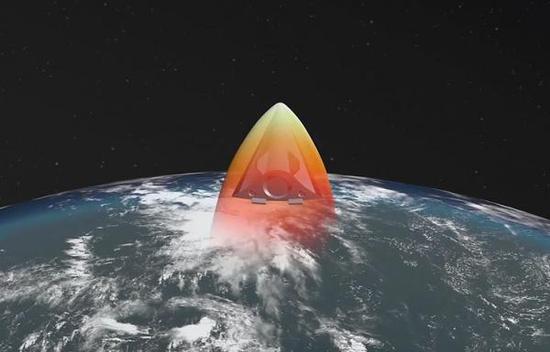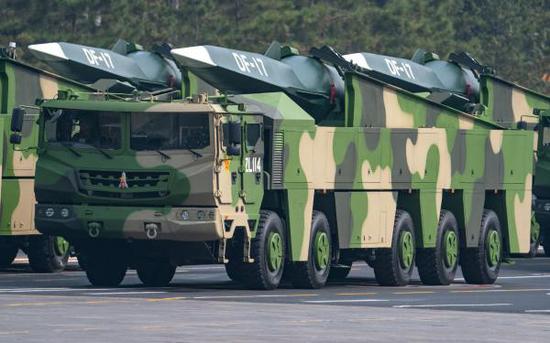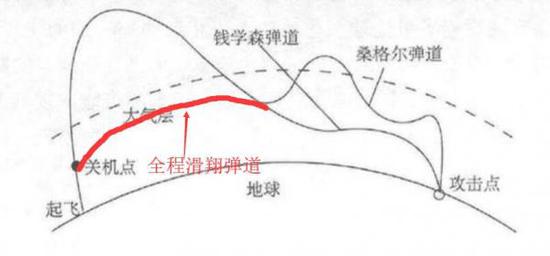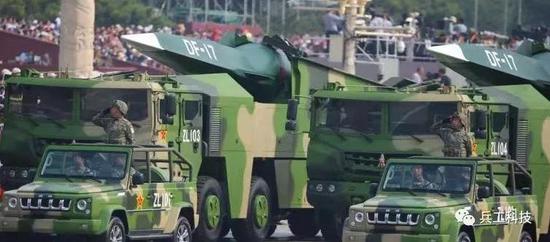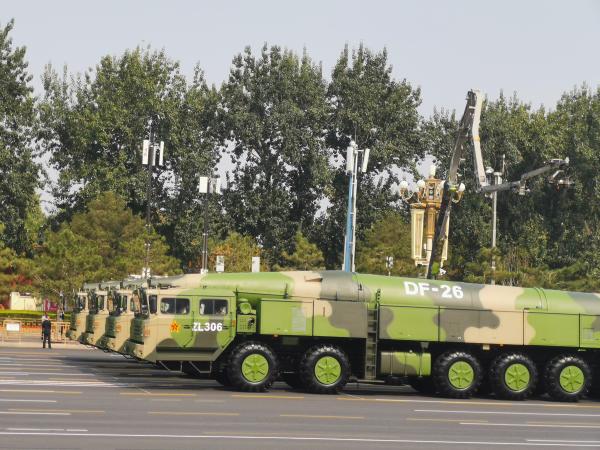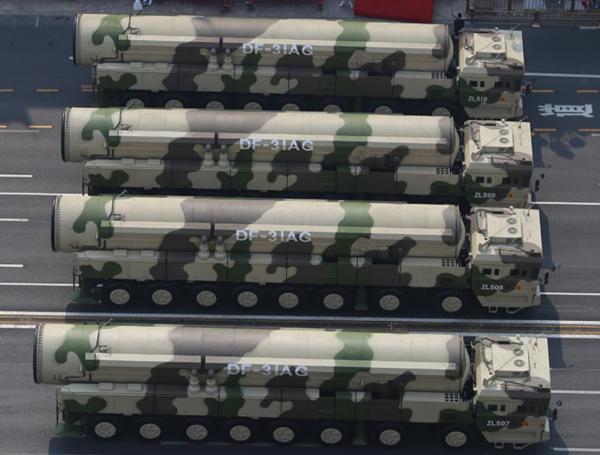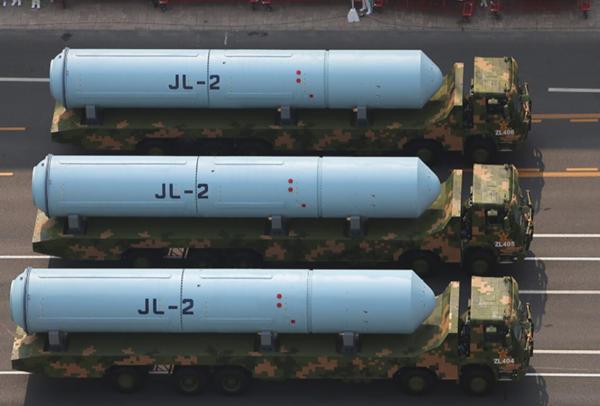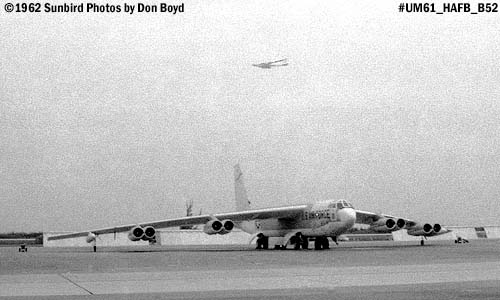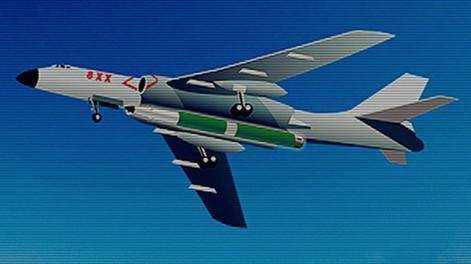China explains more about their Rocket Army nukes displayed at NDP CN-70. Here is a photo taken within the top secret WORLD'S MOST ENORMOUS underground network of NUKE-PROOF TUNNELS called Under-Ground-Great-Walls. From inside there, Rocket Army can shoot anywhere anybody in the world nobody no warhead can shoot them. They are safe and can survive nuke war for years, they have food, water, hospital, nuke energy, military factories, warehouses, greenhouse farms, oxygen from electrolysis of water, they can make missiles and nuke from below. They are able to biuld and launch spare spy and communication satellites, launched from inside like ICMB! Trying to win nuke war against them is impossible.
https://mil.news.sina.com.cn/china/2019-10-04/doc-iicezueu9968506.shtml
东风-31AG导弹可无依托发射 射程高达一万两千公里
东风-31AG导弹可无依托发射 射程高达一万两千公里
254
(文/观察者网专栏作者 席亚洲)
“正义从不迟到”——快速反应的东风-26与东风-31AG
在这次的国庆阅兵中,东风-26导弹再次亮相,与2015年胜利阅兵上解说词强调“具备打击大型水面舰艇目标能力”相比,这次阅兵式上关于这种导弹的解说词和字幕强调了该导弹“核常兼备”的特性。
在事情过去两年后我们也不必讳言,2017年中印边境对峙期间,我国进行了东风-26导弹的试射。当时笔者曾在文章里说我们可以用该导弹打击印度唯一能发射“烈火”导弹的卡拉姆岛试验场,从而解除印度中程导弹的威胁——如果配合前出的东风-16导弹、“翔龙”侦察机,那么印度核威慑的主要装备“大地”短程地对地导弹也会来不及发射,在它停车,加注准备发射的漫长时间里,东风-16能把它炸掉三四次吧。
我国向国际社会承诺不首先使用核武器——但是让我们设想一个极端状况:印度在卡拉姆岛上开始进行“烈火”导弹的发射准备,并且可以确定这将是向中国核心地区发射核弹头。那么携带核弹头的东-26,是要等敌人的导弹落地爆炸并造成我国巨大损失之后再进行还击吗?
这个假想问题没有成为现实,但我们仍然可以考虑。
东风-26具备快速反应能力,只要中央一声令下,可以在几分钟内将核弹头送到敌人头上
印度迄今为止唯一号称“实用化”的中程核导弹“烈火2”实际上却没有开发相应的机动发射系统,而是每次都从大家耳熟能详的卡拉姆岛发射场升空
我只能说,在最坏的情况下,东风-26至少可以在最短的时间内,对敌人施加惩戒。
作为一种核导弹,东-26和比它更大,射程更远的东风-31AG一样,主要的“亮点”在于随处能听,时刻能打,具备快速反应能力。
这种“快速反应”能力,一方面体现在这两种导弹系统总体设计上,其引导、测地、目标信息输入、弹头等各方面都进行了精心设计,来提高反应速度。
在这些系统的配合下,早期机动式导弹发射准备过程中耗时较长的校准陀螺仪、测地、目标信息输入等环节都被缩短到数分钟,甚至一分钟之内。
而且导弹本身也进行了专门的设计,自动化程度更高,发射前准备工作得以大幅度简化。
目前具备无依托发射能力的我军导弹包括东风-21D、东风-16、东风-17、东风-31AG、东风-26,这其中东-31AG、东-26和东-21D发射筒后部有大型橡胶缓冲层
而这里面从外观上能够看得出来的,具备“无依托发射”能力的导弹的特征就是发射筒后部的巨大橡胶垫子。
在1999年时登场的东风-21和东风-31导弹的发射筒后部,是三个支撑脚,来确保导弹发射筒的姿态正确,而这种支撑脚需要配合专门建造的发射阵地,阵地需要进行精确测量,具备硬化地面——这是为了简化导弹发射前的准备工作,提高反应速度——导弹发射车只要按照预设阵地上绘制的标线停好,就完成了这些准备工作。
尽管这类预设阵地可以采用很多技术手段进行隐蔽,但是毕竟其施工建造都不可避免的要暴露在强敌定时过顶的卫星之下,问题只在于他们的判读人员(当然现在可能还用上了大数据AI识别)是否注意到——也就是说这些阵地是否暴露,不是我们能控制的,事实上我们应该默认大部分预设阵地是敌方已经注意到的,他们只是不能确定导弹何时抵达阵地并进行发射而已。
必要时候,强敌甚至可以用常规弹头来攻击我方战略导弹的预设发射阵地,来破坏我方的快速报复能力。
正是因为这种危险的存在,“无依托发射”能力非常有必要——当然了,橡胶垫只是外观识别特征,而不是“无依托发射”的真正关键,所谓“功夫在幕后”嘛。
东风-26导弹在我军核威慑体系中,任务是取代东风-4导弹——传统上来说,东风-4导弹主要是部署在我国西部地区,威慑莫斯科。进入90年代后它又被部署到东南方向威慑关岛基地和亚太地区目标。而东-26,则正如我们前面提到的,在中俄背靠背战略合作关系,威慑莫斯科已经不是主要任务,不过现在我们又增加了一项威慑印度的任务——虽然网上大家开玩笑说,我们被美国上千枚弹头瞄准,不在乎多印度那一点儿,但实际上国家当然不能无视这种威胁。正好东风-26以前威慑莫斯科的部署地点,向南发射也正好可以覆盖印度大部分目标,那就省得建设新的基地了,多准备几组目标数据就是了。
东风-26毕竟是2000年后研制的新型导弹,而我国90年代耗费巨资建设规模宏大的“长城工程”所围绕的主要装备——东风-31,作为第一代机动式固体燃料洲际导弹,它的各方面性能还是比较“基础”的。东风-31导弹最初服役时射程略超过8000公里,只能覆盖美国西海岸部分地区,其“红岩“牵引车的越野性能也近乎没有,快速反应能力较差。因此只能依托”长城工程“进行部署,依靠地下掩体保证生存性,而发射则要依靠掩体周围多个真真假假的预筑发射阵地,目标数据也是事先装订。
“长城工程”地下掩体设施一角
在2009年国庆阅兵上展示的东风-31A导弹,相比东风-31增加了射程,其射程已经达到了一万多公里,可以从我国东北地区发射攻击美国纽约、华盛顿等要害目标。不过其生存性、灵活性,快速反应能力并无本质提高。
而东-31AG正是为了解决这一问题而设计,它采用了与东-41同系列的8轴重型越野发射车,具备无依托发射能力。
对于东-31AG来说,“长城工程”掩体已经只是一个“车库”,战时它将在我国西北、东北的莽莽雪原、丛林戈壁之中停停走走,充分利用地形地物隐藏机动,使敌人无法先发制人将其消灭。
一举将我国的洲际弹道导弹的生存性提高到和俄罗斯“白杨M”导弹相当的水平。
那么既然说到这里了,我们就要谈一下东风-31导弹的射程与载荷问题。
与俄罗斯相比,我国对美国战略威胁的难度更高,因为国土纬度原因,即使利用北极航线,从我国境内相对安全的纵深地区向美国发射核导弹,要覆盖其全境,射程要达到11000公里以上。
而另一方面,我国的核战略是不首先使用核武器——这意味着我国核武器的主要使命是战略威慑,这也就意味着我国的核弹头,当量必须够大。
叶剑英元帅当年在视察空投氢弹的时候表示:“300万吨,杀人放火够了“。就是这个意思,我国的核武器必须具备一举摧毁敌方超级城市、人口中心,或者大范围摧毁敌工农业设施的能力。
当然后来随着对核武器毁伤效果的认识,各国逐渐认识到,多枚50万吨核弹头空爆,其光辐射相应制造的大范围火灾互相影响形成的火焰风暴,可能是摧毁现代大城市目标最有效的技术手段。
因此美国在“三叉戟D5”导弹上配备了300多公斤重,47万吨当量的W88核弹头,这种弹头的重量\当量比是当代人类核弹头中最高的,也堪称是现代核武器的经典设计。
W88弹头
目前美国与W88同时装备的还有W76弹头,165公斤,10万吨当量。
“三叉戟D5”导弹可以携带8个W88,或者14个W76弹头。
而该导弹的射程,公开数据是,“轻载状态下12000公里以上,携带最大载荷时7800公里“。
换句话来说,满载8个W88弹头的“三叉戟D5”射程和我国的“巨浪2”遥测弹试射的射程差不多了。
当然,大家都知道美国90年代“考克斯报告”就声称中国已经“偷取”了W88的设计,从而能制造出类似的弹头。
虽然“偷取”的部分实属污蔑,但我们确实拥有了最先进的核弹头设计制造能力却是没错的。
但即使如此,对于我国来说,W76这样的轻量化弹头意义不大,这种弹头的主要任务是攻击敌方核导弹发射井,利用其100米以内的CEP,10万吨弹头足以摧毁大部分发射井了。但如果用来攻击敌方城市目标,还是以W88这样较为“重型”的弹头更好。
而且按照我国的传统,数百万吨级甚至上千万吨的地爆弹头少不了——和苏联当年的设想相同,这类弹头有两个作用,一个是攻击深藏地下的敌方关键设施;另一个是用来制造成千上万吨随风飘散的放射性尘埃,美国的地理环境特点决定,这种攻击方式对于美国的工农业基础的打击效果是最致命的。
那么通过上面这点分析我们可以看到,我国的战略核武器相比于美苏都要更复杂,射程要远,投送重量要大,突防能力要好,还要快速反应。
也正是因为有这么多麻烦,长期以来美国判断中国“真正”能够覆盖美国全境的就是“20枚东风-5A”导弹。至于东风-31,或许因为其射程只能覆盖西海岸,华盛顿的老爷们可能真的觉得这玩意打不到自己头上就不害怕吧……
其实东风-31AG就已经改变了这一状况,该导弹是单弹头设计,但射程足以达到12000公里,也就是足以覆盖华盛顿了。
当然,要真正具备携带4-5个W88水平核弹头(理论上当然也可以携带10个W76水平的轻型弹头,但不会这么干)的东风-41,才真正足以让美国人感到恐惧。不过东风-41我们下文再说。
可以说,东-31AG是我国第一种让对手无法以“先发制人就能消灭”来蒙混过关的洲际导弹——此前的东-31和东-31A要依托“长城工程“,美军对国会解释可以用核弹攻击长城工程出入口和摧毁预设发射阵地,来阻止它们实施攻击。
或者说,我们可以说东-31AG是我国第一种符合美俄STARTS条约对于洲际导弹相关规定条文内容的机动式洲际导弹(虽然我国当然不会理会STARTS条约)。
“革命尚未成功,同志仍需努力”——继往开来的巨浪-2
本次阅兵中首次亮相的巨浪-2导弹是我国第一种具备洲际射程的潜射弹道导弹,在它之前,“巨浪1”实际上是一种中程弹道导弹,它的岸基型号就是东风-21,射程只有2000公里。所以当时的092型核潜艇,理论上来说只能威慑一下苏联远东地区。
而巨浪-2的技术,很多都和东风-31同源,两者技术水平相当——不过要将东风-31这么大的一个导弹,“压缩”到能装进094那并不特别“伟岸”的身躯内,还得塞进去12发,这难度还是很高的。
也正是因为如此,“东风-31”导弹90年代就已经研制成功,而巨浪2导弹则一直到2014年才具备了作战能力。
不过也正式因为巨浪2的设计基础是来自于东风-31,它的一些基本技术在今天环境下已经算不上最先进了。根据试射验证,巨浪2的射程为8000公里不到一点(当然其载荷情况就恕不告知了),应该说这并不理想,即使考虑采用W76水平的轻型弹头来尽可能减少投掷重量,增加射程达到11000公里(实际上能不能存疑),也只能从南海堡垒区攻击旧金山、洛杉矶等西海岸城市,这个威慑力就有些弱了。
巨浪2目前只能说勉强能实现初步的威慑效果,距离理想水平还有距离
战时要让094进入日本海,才能发射正常载荷攻击美国西海岸,或者继续北上到鄂霍次克海,借用俄国核潜艇的发射阵地,来攻击五大湖区部分工业地带。
这样看来,094型和“巨浪2”对于我军来说,更多的还是解决战略核潜艇的有无问题。而且这里面还有一个重要的考虑,就是积累我军战略核潜艇的使用经验,不论是人员、战术、战法方面,也要检验核潜艇本身的设计、制造,下一代核潜艇的设计和研制,很大程度上来说,也要有现役核潜艇的丰富使用经验来支撑。在这个问题上“不怕慢,就怕停“,我国核潜艇在上世纪90年代到21世纪中间一段时间得到的重视程度不足,如今我们经费充足,国家重视,虽然”巨浪2“的射程勉强了一些,那也总可算差强人意,因此装备一个能够维持1-2艘艇在海上值班的战略核潜艇部队规模,还是很有必要的。
当然,这肯定只是一个过渡阶段,目前“巨浪3”导弹研制进程顺利,这种在“巨浪2”基础上改进导弹将终于具备实现从南海堡垒海区威慑美国全境的能力。不过目前“巨浪3”只能从专用试验潜艇32型上发射,而094的发射筒尺寸无法容纳。这就有一些尴尬了。
未来究竟是对094进行改动,加高龟背以容纳巨浪3导弹,还是等待目前还没有完成设计的新一代核潜艇096呢?这可能也将是一个很值得关注的问题。
“一千次抗议,也不如战略轰炸机振动翅膀——如果带上核导弹就更好了”
——只差一步未能亮相的某型空射远程核导弹
在现代超级大国的战略核威慑体系中,空基核力量作为“三叉戟”的一枝,也是非常重要的装备,而这方面我国长期以来是空白。
空基核力量,或者说战略轰炸机在现代核威慑体系中,主要承担的是“展示力量”的任务。
当然,“三位一体“的具体分工方面,中美俄都略有不同。
美国的“三位一体”系统中,陆基核力量承担着“先发制人”,凭借精度优势,攻击敌方发射井的任务。(因为美国的战略是首先使用核武器)
而海基核力量在美国这边,“三叉戟D5”导弹性能远优于陆基的民兵3,不仅投掷重量大,威力强,突防能力高,而且还能从靠近敌方海岸的地方发射,出其不意。所以它承担着“第一次突击”和“第二次报复”的双重任务,是美国“争取打赢核战争”的关键装备。(美国海军2013年将所有“战斧”导弹的核弹头退役,从此只剩下“三叉戟”一种核打击手段)
空基核力量,由于STARTS条约限制,主要是通过轰炸机发射的巡航导弹来实现。由于AGM-129隐身巡航导弹维护使用价格过于昂贵,已经退役,目前美军使用的巡航导弹是AGM-86空射巡航导弹,该导弹使用的W80弹头具备25万吨的当量。
此外美国空军还掌握着目前美军主要的战术核武器,B61核炸弹,包括B-2、B-1B,以及各种战术飞机都可以投掷这种重量仅为300公斤的战术核弹。
除此之外美军的空投核炸弹和核导弹均已销毁或转为库存——不过由于美军相比俄罗斯经费充足,所以据称有一些B-83核炸弹(1.2百万吨当量)仍处于较好的可用状态。
2018年4月,美国明尼阿波利斯市上空,10家B-2轰炸机和大批KC-135加油机长时间盘旋,这就是战略轰炸机示威行动的一次演练
从这里可以看到,美国空军核武器的主要价值就是展示力量——尽管“战斧”导弹突防能力不强,但确是在局势紧张时刻对对手施加压力的一张牌。至于B-2隐身轰炸机投掷B-61就更是具备潜在的战略价值,因为它完全可以用于攻击对手的发射井,尤其是美国新一代B-61-12精确制导钻地核弹。
相比之下,俄罗斯的海基核力量远不如美国,其新一代“圆锤”导弹几经周折,在最近才终于搞定,但要以“北风之神”和“圆锤”的组合替换老旧的“德尔塔IV”和“轻舟”液体燃料导弹,可能还需要相当的时间。其海基核力量的主要任务就是二次报复。
相比之下,俄罗斯的陆基核力量是其核威慑的主要手段,进攻方面,有SS-18“撒旦“和SS-19,这都是井射导弹,如果对方先发制人容易被摧毁,但如果用于先发制人则很可能消灭对方相当大比例的井射核武器。目前俄罗斯正在更新新一代液体燃料导弹,计划用”萨尔玛特“替代”撒旦“,而部分SS-19则被改进为“先锋”导弹,装备高超声速滑翔弹头。
同时俄罗斯真正寄予厚望的陆基第二次报复力量主要是“白杨”、“白杨M”和“亚尔斯”导弹,在俄罗斯经济上最绝望的90年代,他们仍然咬紧牙关制造了200多枚“白杨”导弹,确保了有效的第二次核反击能力。
古巴导弹危机期间B-52升空盘旋,准备应对核战
相比之下,俄罗斯的空中核力量地位就和美国差不多,主要依靠亚音速巡航导弹投掷核弹头。
主要发挥战时塑造危机,影响形势走向的作用。
而我国的空基核力量,目前尚属空白。
但原本计划参加此次阅兵,由轰-6N携带的某型空射远程战略导弹就是要填补这个空白。
如果这种导弹装备部队,可以说我国空基核力量将具备比目前海军更有效的威慑能力,因为毕竟美俄的战略轰炸机发射亚音速巡航导弹和核炸弹都是考虑打击敌方军事基地等相对“战术”的目标。
而我国的核战略之下,并不需要战术核武器(事实上我军的常规战术打击效能已经高于传统的战术核武器)——那么所有核武器投掷平台唯一要考虑的问题是要威慑哪个对手的人口中心和工业中心而已。
因此,这种新型空射导弹追求能够攻击美国本土的最大射程也就可以理解了。
实际上,我军的轰-6N除了实际担负二次反击任务,更重要的,其实是和美俄的战略轰炸机一样——展示我方战略决心,展示不畏核战争威胁的最高姿态。
轰-6N是我国空基核力量的“新生代”,它不会是终点
2018年4月,美国曾经进行B-2轰炸机紧急起飞,大机群在本国上空盘旋的演习——这正是对于战略轰炸机在战时如何使用的一个鲜活演示。
The Dongfeng-31AG missile can be launched without support. The range is up to 12,000 kilometers.
The Dongfeng-31AG missile can be launched without support. The range is up to 12,000 kilometers.
254
(Text / Observer Network columnist Xi Asia)
"Justice is never late" - rapid response Dongfeng-26 and Dongfeng-31AG
In this National Day military parade, the Dongfeng-26 missile was unveiled again. Compared with the 2015 victory parade, the commentary emphasized that "the ability to combat large-scale surface ships has the ability to attack." Emphasizes the characteristics of the missile "both nuclear and often".
In the past two years, we have no need to say that during the confrontation between China and India in 2017, China conducted a test of the Dongfeng-26 missile. At the time, the author said in the article that we can use the missile to attack the only Karam Island test site in India that can launch a "fire" missile, thereby lifting the threat of India's medium-range missiles - if it cooperates with the Dongfeng-16 missile, "Xiang" "Dragon" reconnaissance plane, then the main equipment of the Indian nuclear deterrent "earth" short-range ground-to-ground missiles will not be able to launch, and it will be blown up three or four times in the long time when it is parked and raised for launch. .
Our country promises to the international community not to use nuclear weapons first – but let us imagine an extreme situation: India is preparing for the launch of the “Agni” missile on Karam Island, and it is certain that this will be the launch of a nuclear warhead to the core of China. Then the East-26 carrying the nuclear warhead is to wait for the enemy's missile to land and explode and cause huge losses in China before returning it?
This hypothetical problem has not become a reality, but we can still consider it.
Dongfeng-26 has the ability to respond quickly, and the nuclear warhead can be sent to the enemy's head in a matter of minutes.
India’s only so-called “utility” medium-range nuclear missile “Agni 2” has not actually developed a corresponding mobile launch system, but every time it is lifted from the well-known Karam Island launch site.
I can only say that in the worst case, Dongfeng-26 can at least impose disciplinary action on the enemy in the shortest possible time.
As a nuclear missile, Dong-26 is the same as the Dongfeng-31AG, which has a larger range and a longer range. The main "bright spot" is that it can be heard everywhere, can be played at any time, and has rapid response capability.
This kind of "quick response" capability is embodied in the overall design of the two missile systems. Its guidance, geodetic survey, target information input, warhead and other aspects have been carefully designed to improve the response speed.
With the cooperation of these systems, the long-time calibration gyroscope, geodesic, target information input and other links in the early maneuver missile launch preparation process were shortened to several minutes or even one minute.
Moreover, the missile itself has been specially designed to be more automated and the preparation work before launch is greatly simplified.
At present, our military missiles with unsupported launch capability include Dongfeng-21D, Dongfeng-16, Dongfeng-17, Dongfeng-31AG, Dongfeng-26, among which the east-31AG, Dong-26 and Dong-21D launchers have large rear Rubber buffer layer
The missile can be seen from the appearance, and the missile with the ability of "no support launch" is characterized by a huge rubber mat at the back of the launcher.
At the back of the launcher of the Dongfeng-21 and Dongfeng-31 missiles, which were launched in 1999, there are three support feet to ensure that the missile launcher is in the correct posture, and this support foot needs to cooperate with the specially constructed launching position. Accurate measurements, with hardened ground – this is to simplify the preparation of the missile before launch and to increase the speed of the reaction – the missile launch vehicle completes the preparations as long as it is stopped according to the markings drawn on the preset positions.
Although this kind of pre-set position can be concealed by many technical means, after all, its construction and construction are inevitably exposed to the satellites with strong enemy timing. The only problem lies with their interpreters (of course, it may still be used now) Whether the big data AI recognition) noticed—that is, whether these positions are exposed, not what we can control. In fact, we should default that most of the preset positions are already noticed by the enemy. They just can’t determine when the missiles are. Arrived at the position and launched.
When necessary, strong enemies can even use conventional warheads to attack the pre-set launch positions of our strategic missiles to undermine our ability to respond quickly.
It is precisely because of this danger that the "no support launch" capability is very necessary - of course, the rubber mat is only the appearance recognition feature, not the real key to "no support launch", the so-called "Kung Fu behind the scenes".
In the nuclear deterrent system of our military, the Dongfeng-26 missile is the task of replacing the Dongfeng-4 missile. Traditionally, the Dongfeng-4 missile was mainly deployed in the western part of China and deterred Moscow. After entering the 1990s, it was deployed to the southeast direction of the Weihai Guam base and the Asia-Pacific target. And Dong-26, as we mentioned earlier, in the back-to-back strategic partnership between China and Russia, deterrence Moscow is not the main task, but now we have added a mission to deter India - although everyone on the Internet joked that we were Thousands of US warheads are aimed at the United States, and they don’t care much about India. But in reality, the country certainly cannot ignore this threat. Just before the Dongfeng-26 deterrently deployed the location of Moscow, the southward launch can also cover most of India's targets, which saves the construction of new bases. It is enough to prepare several sets of target data.
After all, Dongfeng-26 is a new type of missile developed after 2000, and China’s main equipment around the 1990s, which was heavily invested in the construction of the “Great Wall Project”, Dongfeng-31, as the first generation of mobile solid fuel intercontinental missiles, Its performance in all aspects is relatively "basic". When the Dongfeng-31 missile was first put into service, it had a range of more than 8,000 kilometers and could only cover parts of the west coast of the United States. Its off-road performance of the "Red Rock" tractor was almost non-existent, and its rapid response capability was poor. Therefore, it can only rely on the "Great Wall Project" to deploy, relying on the underground bunker to ensure survivability, and launching depends on a number of real and fake pre-built launch positions around the bunker, the target data is also bound in advance.
The corner of the "Great Wall Project" underground bunker facility
The Dongfeng-31A missile displayed at the National Day military parade in 2009 has increased its range compared to Dongfeng-31. Its range has reached more than 10,000 kilometers, and it can launch targets from the northeastern region of China to attack the United States, New York and Washington. However, its survivability, flexibility, and rapid response ability are not substantially improved.
The East-31AG is designed to solve this problem. It uses the 8-axis heavy-duty off-road launcher in the same series as the East-41, with unsupported launch capability.
For the East-31AG, the "Great Wall Project" bunker is just a "garage". During the war, it will stop and walk in the snowfields and jungle Gobi in the northwest and northeast of China, making full use of the topographic features to hide maneuvering. The enemy cannot preempt the person to destroy it.
In one fell swoop, the survivability of China's intercontinental ballistic missiles has been raised to the level comparable to the Russian "White Poplar M" missile.
So since we are here, we will talk about the range and load of the Dongfeng-31 missile.
Compared with Russia, China’s strategic threat to the United States is more difficult. Because of the latitude of the country, even if the Arctic route is used, nuclear missiles will be launched from the relatively safe deep areas of China to the United States, covering a whole area with a range of 11,000 kilometers. the above.
On the other hand, our nuclear strategy is not to use nuclear weapons first — which means that the main mission of our nuclear weapons is strategic deterrence, which means that our nuclear warheads must be large enough.
When Marshal Ye Jianying inspected the air-dropping hydrogen bomb, he said: "3 million tons, killing and arson is enough." It is this meaning that our nuclear weapons must have the ability to destroy enemy super-cities, population centers, or extensively destroy enemy agricultural facilities.
Of course, with the understanding of the effects of nuclear weapons damage, countries gradually realized that many 500,000 tons of nuclear warheads were air-exploded, and the flame storm formed by the mutual influence of large-scale fires caused by optical radiation may be the most effective to destroy the targets of modern big cities. Technical means.
Therefore, the United States is equipped with more than 300 kilograms of weight and equivalent weight of 470,000 tons of W88 nuclear warheads on the Trident D5 missile. The weight/equivalent ratio of this warhead is the highest among contemporary human nuclear warheads. It is also a classic design of modern nuclear weapons. .
W88 warhead
At present, the United States and W88 are also equipped with W76 warheads, 165 kg, 100,000 tons of equivalent.
The Trident D5 missile can carry eight W88 or 14 W76 warheads.
The missile's range, the open data is, "12,000 km under light load conditions, 7800 km when carrying the maximum load."
In other words, the range of the "Trident D5" with eight W88 warheads and the range of the "Julang 2" telemetry bomb test in China are almost the same.
Of course, everyone knows that the "Cox Report" of the United States in the 1990s claimed that China had "stealed" the design of the W88, so that it could produce a similar warhead.
Although the "stealing" part is really filthy, we do have the most advanced nuclear warhead design and manufacturing capabilities.
Even so, for China, the lightweight warhead of the W76 is of little significance. The main task of this warhead is to attack enemy nuclear missile silos, using its CEP within 100 meters, and 100,000 tons of warheads are enough to destroy most of the warheads. The silo is gone. But if it is used to attack enemy city targets, it is better to use a "heavy" warhead like W88.
Moreover, according to China's tradition, millions of tons of tens of thousands of tons of ground-explosive warheads are indispensable - the same as the Soviet Union's vision of the year, these warheads have two functions, one is to attack the enemy's key facilities buried deep underground; The other is used to make thousands of tons of radioactive dust scattered in the wind. The geographical environment of the United States determines that this attack is the most deadly effect on the industrial and agricultural base of the United States.
From the above analysis, we can see that China's strategic nuclear weapons are more complicated than the United States and the Soviet Union. The range is far, the delivery weight is large, the penetration capability is better, and the response is quick.
It is precisely because of so much trouble that the United States has long judged that China’s “real” can cover the entire United States is the “20 Dongfeng-5A” missiles. As for Dongfeng-31, perhaps because its range can only cover the West Coast, Washington's lords may really feel that this thing is not afraid of hitting their heads...
In fact, the Dongfeng-31AG has changed this situation. The missile is a single-head design, but the range is enough to reach 12,000 kilometers, which is enough to cover Washington.
Of course, to really have the Dongfeng-41 with 4-5 W88 horizontal nuclear warheads (theoretically, of course, it can carry 10 W76 horizontal light warheads, but it won't do this) is really enough to make Americans feel fear. But Dongfeng-41 we will talk about below.
It can be said that the East-31AG is China's first intercontinental missile that allows opponents to pass the "preemptive strike". Previously, the East-31 and East-31A relied on the "Great Wall Project," and the US military explained to Congress. Use nuclear bombs to attack the Great Wall project entrances and exits and destroy the preset launch positions to prevent them from carrying out attacks.
In other words, we can say that the East-31AG is China's first mobile intercontinental missile that conforms to the provisions of the US-Russia STARTS treaty on intercontinental missile-related provisions (although China certainly will not pay attention to the STARTS treaty).
"The revolution has not been successful, and comrades still need to work hard" - the huge wave of the future
The Julang-2 missile, which debuted in this military parade, was the first submarine-launched ballistic missile with intercontinental range in China. Before it, "Julang 1" was actually a medium-range ballistic missile, its shore-based model. It is Dongfeng-21 with a range of only 2,000 kilometers. Therefore, the Type 092 nuclear submarine at that time could only deter the Soviet Union in the Far East.
And the technology of JuLang-2, many of them are the same as Dongfeng-31, the technical level of the two is quite the same - but to "compress" a missile such as Dongfeng-31, it can not be loaded into 094. In the body, I have to put in 12 rounds, which is still very difficult.
It is precisely because of this that the "Dongfeng-31" missile was successfully developed in the 1990s, and the Julang 2 missile did not have the combat capability until 2014.
However, it is also officially because the design basis of Julang 2 is from Dongfeng-31, and some of its basic technologies are not the most advanced in today's environment. According to the test test, the range of JL 2 is less than 8,000 km (of course, the load will not be informed), it should be said that this is not ideal, even considering the use of W76 horizontal light warhead to minimize throwing weight, Increasing the range to 11,000 kilometers (in fact, can not be doubtful), can only attack the West Coast cities such as San Francisco and Los Angeles from the South China Sea Fortress area, this deterrent is somewhat weak.
JuLang 2 can only say that it can achieve the initial deterrent effect, and there is still a distance from the ideal level.
In the war, 094 should enter the Sea of Japan to launch normal loads to attack the West Coast of the United States, or continue north to the Sea of Okhotsk and borrow the launch positions of Russian nuclear submarines to attack some industrial areas in the Great Lakes.
In this way, the 094 and "Julang 2" are more of a problem for our military to solve the problem of strategic nuclear submarines. Moreover, there is another important consideration here. It is to accumulate experience in the use of our military strategic nuclear submarines. In terms of personnel, tactics, and tactics, we must also test the design and manufacture of nuclear submarines. The design and development of next-generation nuclear submarines is very large. To a certain extent, there must be rich experience in the use of active nuclear submarines to support. On this issue, "not afraid of slowness, I am afraid of stopping." China’s nuclear submarines have received insufficient attention in the middle of the 1990s to the 21st century. Now we are well funded and the state attaches importance to it, although the range of "Julang 2" is barely strong. Some, it can always be considered unsatisfactory, so it is necessary to equip a strategic nuclear submarine force capable of maintaining 1-2 boats on duty at sea.
Of course, this is definitely only a transitional stage. At present, the development of the "Julang 3" missile is going smoothly. This improved missile on the basis of "JuLang 2" will finally have the ability to deter the entire US from the South China Sea Fortress. However, at present, "Julang 3" can only be launched from the special test submarine type 32, and the size of the 094 launch tube cannot be accommodated. This is a bit embarrassing.
Is the future a change to the 094, raising the turtle's back to accommodate the Julang 3 missile, or waiting for the new generation of nuclear submarines 096 that have not yet been designed? This may also be a very interesting issue.
"A thousand protests are not as good as a strategic bomber's wings. It would be better if you took a nuclear missile."
——A type of air-launched remote nuclear guide that has not been revealed in one step












